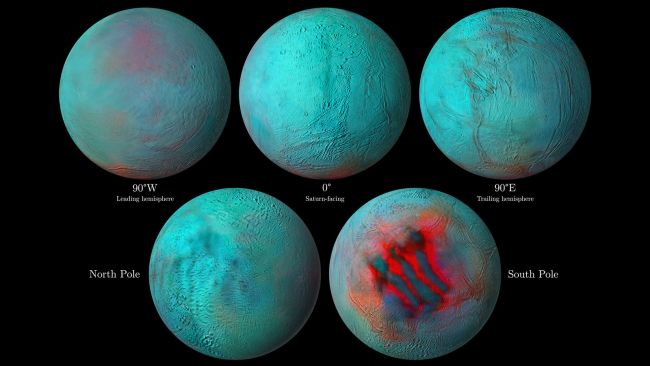Search the Community
Showing results for tags 'Saturn'.
-
In these detailed infrared images of Saturn's icy moon Enceladus, reddish areas indicate fresh ice that has been deposited on the surface. (Image credit: NASA/JPL-Caltech/University of Arizona/LPG/CNRS/University of Nantes/Space Science Institute) Saturn's geyser-spewing moon Enceladus may be even more active than scientists had thought. Fresh images created using data from NASA's dead Cassini spacecraft show that Enceladus' northern hemisphere was resurfaced with ice relatively recently. This new information adds to the known activity in the southern hemisphere, where Cassini spotted more than 100 geysers blasting icy water into space. Researchers spotted the northern changes after looking at the heat signature of Enceladus, using reflected sunlight parsed with Cassini's visible and infrared mapping spectrometer instrument, or VIMS. "Thanks to these infrared eyes [on Cassini], you can go back in time and say that one large region in the northern hemisphere appears also young and was probably active not that long ago, in geologic timelines," Gabriel Tobie, a study co-author and VIMS scientist at the University of Nantes in France, said in a NASA statement. The team combined VIMS data with visible imagery captured by Cassini to create a new, global map of Enceladus in multiple wavelengths of light, both infrared and visible. The map shows that the infrared signals correlate with recent geologic activity on the moon, the researchers said. For example, heat signatures match up with the "tiger stripe" gashes near Enceladus' south pole. The tiger stripes are the launch pad for the moon's dramatic geysers, which send water and other material from Enceladus' subsurface ocean out into the void. To the surprise of scientists, however, the new map also shows infrared features in the moon's northern hemisphere. The data suggests that icy resurfacing also happened up north, but how is not yet clear. The changes could have been due to more icy jets, or slower ice movements through cracks in the crust, team members said. Enceladus is one of the most promising abodes for alien life in the solar system. In addition to the subsurface ocean and geological activity, the moon likely has an energy source that organisms could tap into — chemical reactions perhaps similar to those that sustain life near Earth's deep-sea hydrothermal vents. There is no future mission planned yet to target Enceladus, although scientists made the pitch for one during a presentation coordinated by the U.S. National Academies of Sciences on March 31. In the meantime, researchers must rely on data collected by older missions. Cassini will be a continuing help in providing such information. The mission gathered data about Saturn and its many moons for 13 years before, low on fuel, it was sent on a deliberate suicide plunge into the gas giant's thick atmosphere. Cassini's long-term observations show how the planet and its moons changed over time, providing vital questions for future spacecraft to explore in more detail. The new study was published online last month in the journal Icarus. The research was led by Rozenn Robidel, a researcher at the laboratory of planetology and geodynamics at France's National Centre for Scientific Research (CNRS).
-
Saturn's bold rings are not its only signature feature. Saturn also boasts a six-sided feature at its north pole, which scientists first noticed when NASA's Voyager 2 spacecraft visited Saturn in 1981. Saturn's hexagon is mesmerizing but also odd: the strange phenomenon only appears at the planet's north pole. In a new study, a researching duo investigated the dynamics of Saturn's churning gas to figure out what sorts of planetary fluid dynamics are creating this mystifying structure. Last year, Rakesh Yadav and Jeremy Bloxham from the Department of Earth and Planetary Sciences at Harvard University in Cambridge, Massachusetts, performed a monthlong computer simulation to understand the physics behind Saturn's hexagon. According to their paper, atmospheric flows within Saturn create large and small vortexes near the ringed planet's north pole. A strong horizontal jet that runs about 60 degrees latitude above the equator gets pinched and confined by these vortexes, which defines the rim of the hexagon. One of the main points of the paper, according to Yadav, is that the vortexes do exist, but churn deep beneath the cloud tops and are therefore mostly invisible to spacecraft that have flown over Saturn like Voyager 2 and, more recently, NASA's Cassini mission. After the Voyager 2 data came back to Earth, scientists hypothesized that the hexagon could have been caused by subsurface cyclones like this new study suggests. Although Cassini's observations of Saturn from 2004 to 2017 helped scientists learn more about the planet's fluid dynamics, the theory about subsurface vortexes didn't hold much footing when the spacecraft didn't spot prominent signs of their existence, Yadav said. Yadav performed model simulations of deep turbulent compressible convection, a phenomenon that happens when material at the bottom of a thick, multilayered substance of liquid or gas is hot at the bottom and cool at the top. That difference in temperature causes material to move in a circular up-down motion. Convection is pervasive throughout nature and is what creates hurricanes and tornadoes on Earth. Yadav said the phenomenon is similar to what happens when someone puts cold water into a pot, ignites their stovetop and begins to heat up this water. The heat from the bottom of the pan stirs up the water as the water transfers heat upwards to the colder surface. Yadav said their simulation captured the physics behind the one-pole hexagon and offered up the possibility that in the past, Saturn may have had a hexagon in the south pole and not in the north pole, or maybe a hexagon at each pole. The simulation didn't achieve a hexagonal shape; it produced an angled object with nine sides instead of six. But the mechanics behind their simulation suggest that subsurface vortexes are behind the geometrical feature, Yadav said. "It's very possible that with different conditions we can easily get six edges instead of nine." The computer simulations were challenging to run and researchers can only do small studies within existing parameters. This paper reported one case and Yadav hopes that researchers can run more cases in the future to better understand Saturn's beauty mark. Cassini image of Saturn’s north pole and hexagon from Nov. 27, 2013 (NASA/JPL/SSI) Source: https://www.space.com/saturn-hexagon-subsurface-vortexes.html
-
- 3
-

-

About Us
We are glad you decided to stop by our website and servers. At Fearless Assassins Gaming Community (=F|A=) we strive to bring you the best gaming experience possible. With helpful admins, custom maps and good server regulars your gaming experience should be grand! We love to have fun by playing online games especially W:ET, Call of Duty Series, Counter Strike: Series, Minecraft, Insurgency, DOI, Sandstorm, RUST, Team Fortress Series & Battlefield Series and if you like to do same then join us! Here, you can make worldwide friends while enjoying the game. Anyone from any race and country speaking any language can join our Discord and gaming servers. We have clan members from US, Canada, Europe, Sri Lanka, India, Japan, Australia, Brazil, UK, Austria, Poland, Finland, Turkey, Russia, Germany and many other countries. It doesn't matter how much good you are in the game or how much good English you speak. We believe in making new friends from all over the world. If you want to have fun and want to make new friends join up our gaming servers and our VoIP servers any day and at any time. At =F|A= we are all players first and then admins when someone needs our help or support on server.




